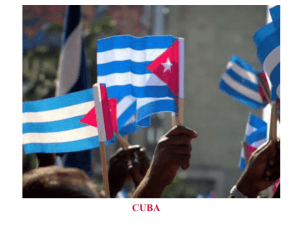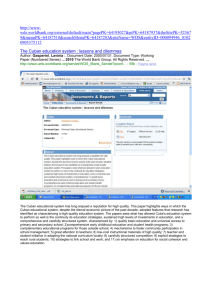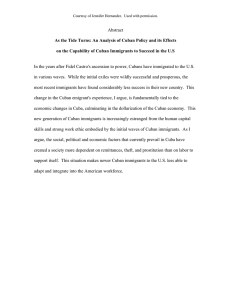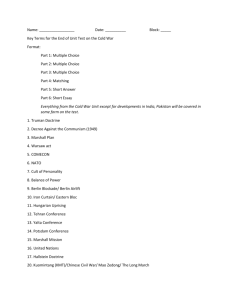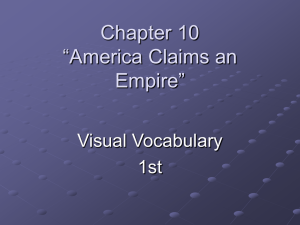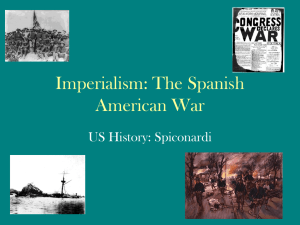V C : H
advertisement
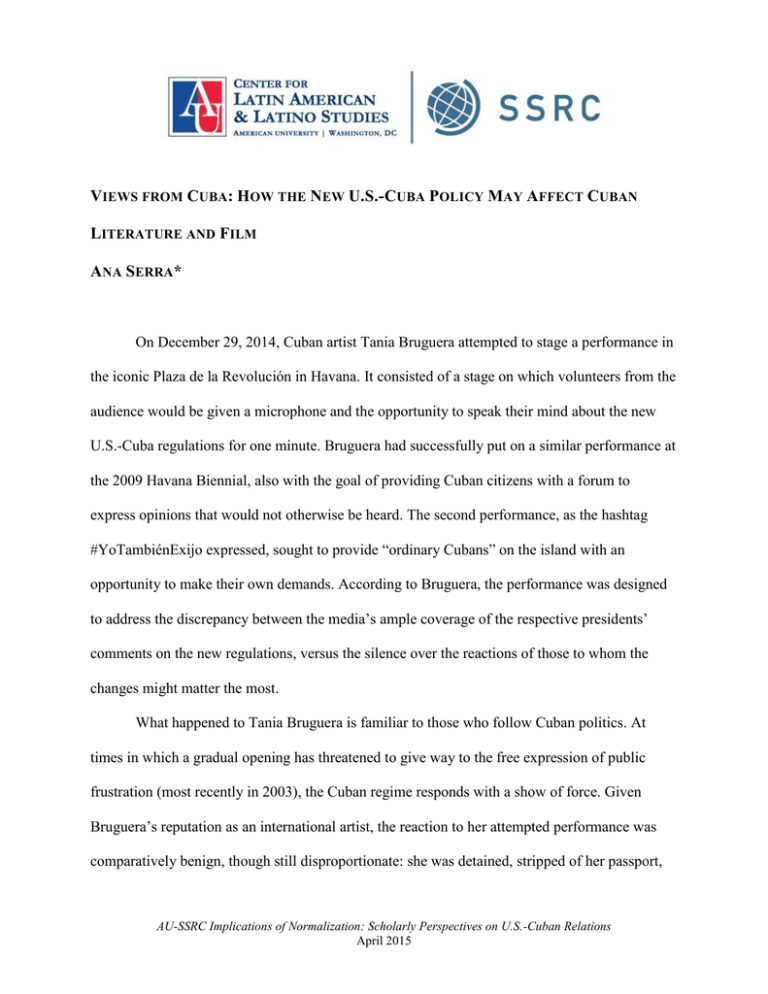
VIEWS FROM CUBA: HOW THE NEW U.S.-CUBA POLICY MAY AFFECT CUBAN LITERATURE AND FILM ANA SERRA* On December 29, 2014, Cuban artist Tania Bruguera attempted to stage a performance in the iconic Plaza de la Revolución in Havana. It consisted of a stage on which volunteers from the audience would be given a microphone and the opportunity to speak their mind about the new U.S.-Cuba regulations for one minute. Bruguera had successfully put on a similar performance at the 2009 Havana Biennial, also with the goal of providing Cuban citizens with a forum to express opinions that would not otherwise be heard. The second performance, as the hashtag #YoTambiénExijo expressed, sought to provide “ordinary Cubans” on the island with an opportunity to make their own demands. According to Bruguera, the performance was designed to address the discrepancy between the media’s ample coverage of the respective presidents’ comments on the new regulations, versus the silence over the reactions of those to whom the changes might matter the most. What happened to Tania Bruguera is familiar to those who follow Cuban politics. At times in which a gradual opening has threatened to give way to the free expression of public frustration (most recently in 2003), the Cuban regime responds with a show of force. Given Bruguera’s reputation as an international artist, the reaction to her attempted performance was comparatively benign, though still disproportionate: she was detained, stripped of her passport, AU-SSRC Implications of Normalization: Scholarly Perspectives on U.S.-Cuban Relations April 2015 and isolated from her family, friends, and the artistic community for a few days. Several artists who publicly decried her arrest were also jailed. Though these unfortunate events were more highly publicized in U.S. news and social media than in Cuba, they make one wonder: To the extent that the arts in Cuba are a vehicle for self-expression, will a more fluid relationship with the United States provide an outlet for the opinions of island Cubans through the arts? How will renewed relations with the United States impact the production, circulation, and reception of the arts in Cuba? While forecasting the future is risky, significant changes in the relationship between the countries in the last two decades allow for calculated predictions. As travel, transportation, and financial transactions become more expeditious, the new regulations may facilitate the circulation and reception of Cuban artistic production in the U.S. However, production and reception may be hampered by the removal of what has been variously called “the forbidden fruit,” “the nostalgia paradise,” or the “Post-Soviet exotic” factor. Overall, outcomes will differ depending on the type of artistic expression and its history prior to the U.S.-Cuba opening. Due to space constraints, this essay focuses on Cuban literature and film, which have had a weaker presence in the United States in the last two decades than Cuban visual arts and music, and therefore have the potential to experience deeper change. The new regulations will remove obstacles and shape Cuban art and music production in ways that deserve separate treatment. Cuban Literature: The Lure of the Post-Colonial The Special Period in Times of Peace brought unprecedented economic hardship to the island nation and, most importantly for Cuban literature, a dire paper scarcity. With the exception of educational materials, book publication was nearly stalled, and literary production 2 was almost completely reduced to poems or short stories that circulated informally in manuscript form. In 1993, perhaps as a means of providing alternative publication venues or coinciding with a general opening of the regime, a government decree allowed writers to negotiate contracts with foreign publishers independently from state organizations, and inaugurated an era of renewed cultural relationships between Cuba and Spain. Major Spanish publishers devoted themselves to printing Cuban as well as Latin American fiction, as part of a generalized post-1992—the Quinto Centenario or Five-Hundredth Anniversary of the “Discovery of America”—effort to revitalize Spanish presence in the region. Spanish publishers set up literary awards, events, and publications to promote Cuban writers, some of whom published their entire literary production in Spain before they were published in their homeland. At the end of the 1990s, a vibrant group of exiled Cuban writers established themselves in Madrid and Barcelona. Headed by the influential Jesús Díaz, they founded the literary and culture journal Encuentros de la cultura cubana, which became a true meeting forum for showcasing artists and promoting debate on Cuban arts, from the perspective of the island as well as the diaspora. The boom of Cuban literature published in Spain resulted in turn in numerous novels, as well as essays and opinion pieces, by Spanish writers engaging with Cuban topics and exhibiting varying degrees of accuracy, as I have argued elsewhere. As the Cuban writer Ángel Esteban put it, “¡Madrid habanece!,” meaning that the enthusiasm for all things Cuban and the heightened presence of Cubans in the city signified a new dawning of Havana in Madrid. Since then, the effervescence of Cuban culture has somewhat diminished in Spain, but significant Cuban authors continue to settle in Spanish cities, just as new popular Cuban writers still publish their fiction in Spain. In turn, Spanish writers supportive of Cuba have published on the island and been given the chance to participate in key events, such as the Feria del Libro in Havana. 3 In the midst of the mutual love fest between Spanish and Cuban cultural spheres, and given the linguistic, political, and economic barriers between Cuba and the United States, Cuban writers have not focused on publishing in the United States. Nevertheless, the novels of popular Cuban writers such as Leonardo Padura, who still lives on the island, have been made available in English by British translators such as Peter Bush, published in London, and garnered a following among U.S. readers. Some works by Abilio Estévez, Antonio José Ponte, and Wendy Guerra, among others, have been published in translation, generally by minor publishing houses in the United States. Similarly, several Cuban short story collections have been printed in English, the most recent and notable example being Generation Zero, by Orlando Luis Pardo Lazo. Relatively minor presses such as Arte Público have published Cuban novels in Spanish in the U.S., though again short story collections by multiple authors seem to have generated more interest for publication in their original language. Fiction by Cuban American writers, however, is widely disseminated in the United States, which attests to the popularity of Cristina García, Achy Obejas, and Roberto Fernández, among many others. Despite the fact that Cuban writers have not published widely in English in the United States, their works published in Spanish elsewhere have been made readily available to U.S. readers, chiefly by Amazon. The new U.S.-Cuba policy will presumably neither hurt nor help this market, in strictly practical terms. Further, the availability of Cuban books in Spanish has aided the development of Cuban Studies in the United States, which has grown considerably in the last decade. To cite one source, at the Latin American Studies Association (LASA) conference, there were 152 panels on Cuba in 2010, versus 410 in 2015. Without a doubt, a more straightforward relationship between Cuba and the United States will facilitate the process of obtaining visas for visiting scholars and will soon make it much easier to remunerate writers and 4 speakers coming from the island. New regulations will soon simplify the translation and publication of Cuban works, given that communication, travel, and royalty exchanges will soon be more predictable. What remains to be seen is what will happen when the “forbidden fruit” factor is removed for critics and readers of Cuban literature. Will the freedom that the U.S. enjoys in travel, communication, and economic exchange with Cuba result in a loss of interest in the country? Will Cuban literature remain highly appreciated despite the fact that the landscapes and the people it represents are no longer impossible to visit? Once the nostalgia for a simpler past or a communist utopia dissipates, once one can enjoy in Cuba some of the same products one enjoys in the global market, will interest in Cuban literature with its (for some) attractive representations of ruin and scarcity remain strong? Will Cuban literary production change to reflect new realities, or will it cater to the desire for a tropical paradise or utopia still held by a certain generation of people in the United States? Where will Cuban Americans stand when they witness changes in the island: will they crave more of the nostalgic representations of prerevolutionary times already seen in Cuban literature? One can only trust that Cuban writers and intellectuals will use the lessons learned when publishing in other countries and have the chance to reflect on the new realities brought by the opening to the U.S. Will more direct exposure to U.S. tourists and products reinstate the once-strong U.S. cultural influence on the island? One can hope that Cuban literature will continue to evolve, moving away from patterns that, in recent times, have been largely influenced by foreign fantasies of the island toward modes of expression that negotiate change and gradual integration with the rest of the world. Above all, one can expect that Cuban literature on and off the island will continue to exhibit the unique aspects of its creativity and imagination, idiosyncrasy, and, yes, politics and history. 5 Cuban Cinema: Finally Unveiling a “True” Image? Since the Special Period, when the funding of the Instituto Cubano de Arte e Industria Cinematográfica (ICAIC) was considerably reduced, Cuban filmmakers have had to resort to coproductions with other countries, chiefly Spain, Mexico, France, or Canada. Co-productions have had an impact on the kinds of films made, as Cuban directors have had to work with a number of actors and technicians from the co-financing countries and, most importantly, the movies needed to respond to the expectations of European or North American audiences. As Cuban director Pastor Vega put it, co-productions meant thinking about “marketing,” “profits,” and a more centralized production process, all unfamiliar concepts to Cuban filmmakers. Since ICAIC’s influence has declined, independent filmmaking by recent graduates of Cuban film schools has proliferated: with hand-held cameras and innovative techniques, these films have redefined the production and distribution of films in Cuba, as films are now made with very low budgets and distributed largely on the internet or at local festivals. Due to the embargo, U.S. filmmakers have only had limited access to Cuba during the same time that the island has opened itself considerably to other markets and audiences. Significantly, under Obama’s recent regulations, documentary filmmaking in Cuba by U.S. citizens will no longer require special permission from the U.S. Treasury Department. Logistics will be considerably easier once credit card payments are authorized and communications improved. Significantly, though, feature-length commercial films are not yet specifically authorized, a decision that deserves further analysis. Granted, documentary filmmaking in Cuba can be justified under the familiar rubrics of “educational or humanitarian purposes,” but these same objectives can arguably be achieved with fictional stories. By authorizing documentary films, the U.S. government seems to succumb to the desire for “realistic representations” of 6 Cuba, to somehow seek “the truth” about the island, as is indeed the premise upon which most documentary films rest. The fact that Cuba has been so inaccessible to the U.S. intensifies the impulse to document what is unique in the island and has been well-preserved throughout years of isolation. It is thus not surprising that, according to the Associated Press, actor Matt Dillon is working on a film on Afro-Cuban music and The Discovery Channel is preparing a documentary on the creative abilities of Cuban car mechanics to keep their 1950s American cars on the road. The relaxation and ultimate lifting of the embargo will paradoxically restrict access to film and television from the U.S. in Cuba. So far, the Instituto Cubano de Radio y Televisión (ICRT) has been at liberty to pirate entire American series, such as The Sopranos. Even Oscarnominated films are watched in private homes in Cuba months before they are exhibited in movie theaters in Europe. While Netflix executives are rubbing their hands in anticipation of business with the island, it would be far more advantageous for Cubans to continue with their home-grown weekly service of el paquete, which—for a couple of convertible pesos— delivers to their home an assortment of foreign programming and films. Establishing a legal framework for film distribution and reception will make it more costly for Cuban institutions and individuals to access U.S. entertainment, and the island’s internet system will have to be thoroughly strengthened to be able to handle downloading on-demand movies. The new regulations, ironically, will also make it more difficult to access Cuban movies in the U.S. Despite the fact that Cuba reinstated copyright laws in 1996, most Cuban commercial and even independent films can be watched on YouTube and various pirate sites for free. Nevertheless, because of a lack of publicity, these films’ audiences seem largely restricted to students of Cuban culture and to the Cubans/Cuban Americans who feel entitled to disseminate these movies on the net. To the detriment of access, after a costly transition Cuban movies will presumably reach a larger 7 audience when new regulations are put in place, and Cuban film creators will receive long overdue profits for their work. Cuba’s proximity to the U.S. and the history of love/dependency and enmity between the two countries has kept the flame of mutual interest alive. These are the factors that presumably compelled celebrities such as Sean Penn to travel to Havana and interview Raúl Castro in 2008 or, more recently, Beyoncé and Jay-Z to celebrate their honeymoon on the island. The allure of the forbidden and the unknown, together with the “lush tropical landscapes,” as well as “the locations that still look like the 1950s” (as an article from The New York Times evokes) can keep the interest in Cuba alive for some time. But what will happen when travel and filming in Cuba becomes routine for U.S. filmmakers, and Cuban filmmakers can make and distribute their films easily in the United States? Clearly, the Cuban filmmaking industry cannot compete with Hollywood or even U.S. independent film, and it would not be cost-effective for Cuban filmmakers to shoot in the United States. It will be interesting to see how the now-fledgling Cuban filmmaking style competes with those of other established cinemas in Latin America, such as in Mexico, Argentina, or Brazil. If the relationship between Hollywood and Cuba partly depends on the latter offering the images that U.S. audiences crave, will Hollywood be able to move beyond the familiar topics? Can we expect that Cuban American filmmakers will be drawn to the island to get acquainted with an ever-changing environment, or perhaps some will persist in trying to rescue landmarks of the past? Can Hollywood, with more means and a remarkably better distribution, serve as a vehicle for new Cuban expressions? Will the new regulations make equipment more accessible for Cuban filmmakers, to the point that their styles will change? The answers to these questions are elusive, but the inquiry seems to point toward one direction: the new regulations will certainly be advantageous for U.S. filmmakers, in that they will have access 8 to new settings and topics, but Cuban filmmakers will have to strive—literally—to protect their image and find new ways of expression to compete in the global market. Let Cubans Speak Once finance, access, travel, and communications become smoother between both countries, there is little doubt that cultural production and circulation will be stimulated. Questions remain about the quality and substance of this production, and whether mutual interest is sustainable in the long run. But equally important is the question with which this inquiry started: if restrictions to free speech in Cuba have been a concern decades before the 1959 revolution, will a predicted artistic explosion occur in the context of a willingness to let all manner of Cuban voices be heard? Once again, the Special Period offers some room for foresight: since the 1990s, Cuban arts have provided a forum to discuss matters of race, gender/sexuality, and class that were considered too controversial in the past. Perhaps Tania Bruguera’s performance was too close to a reality scene: giving Cuban passersby a microphone was deemed too political at this point of uncertainty. It will be exciting to see Cuban intellectuals, writers, and filmmakers continue to explore the possibilities of new and nuanced means of expression for themselves and an increasingly strong Cuban civil society. *Ana Serra is Associate Professor of Spanish and Latin American Studies at American University in Washington, DC. and author of the book The “New Man” in Cuba: Culture and Identity in the Revolution (2007), as well as other publications on Cuban culture and its diaspora. 9

